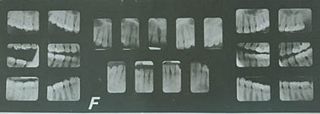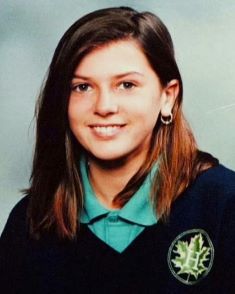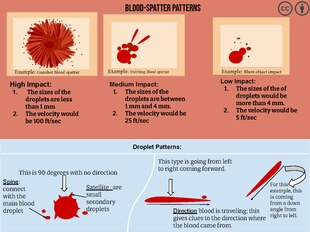
Forensic science, also known as criminalistics, is the application of science principles and methods to support legal decision-making in matters of criminal and civil law.

Forensic palynology is a subdiscipline of palynology, that aims to prove or disprove a relationship among objects, people, and places that may pertain to both criminal and civil cases. Pollen can reveal where a person or object has been, because regions of the world, countries, and even different parts of a single garden will have a distinctive pollen assemblage. Pollen evidence can also reveal the season in which a particular object picked up the pollen. Recent research into forensic palynology has seen advancements in DNA barcoding from pollen, to the level of singular pollen molecules, allowing DNA profiles to be created from singular palynomorphs, streamlining the efficiency and accuracy of taxonomic identification.

Forensic dentistry or forensic odontology involves the handling, examination, and evaluation of dental evidence in a criminal justice context. Forensic dentistry is used in both criminal and civil law. Forensic dentists assist investigative agencies in identifying human remains, particularly in cases when identifying information is otherwise scarce or nonexistent—for instance, identifying burn victims by consulting the victim's dental records. Forensic dentists may also be asked to assist in determining the age, race, occupation, previous dental history, and socioeconomic status of unidentified human beings.

Henry Chang-Yu Lee is a Chinese-born American forensic scientist. He founded the Henry C. Lee Institute of Forensic Science, affiliated with the University of New Haven. In July 2023, a federal court found that Lee fabricated evidence that sent two teens to prison for 30 years.

Hair analysis may refer to the chemical analysis of a hair sample, but can also refer to microscopic analysis or comparison. Chemical hair analysis may be considered for retrospective purposes when blood and urine are no longer expected to contain a particular contaminant, typically three months or less.
Michael Iver Peterson is an American novelist who was convicted in 2003 of murdering his second wife, Kathleen Peterson, on December 9, 2001. After eight years, Peterson was granted a new trial after the judge ruled a critical prosecution witness gave misleading testimony. In 2017, Peterson submitted an Alford plea to the reduced charge of manslaughter. He was sentenced to time already served and freed.
Forensic identification is the application of forensic science, or "forensics", and technology to identify specific objects from the trace evidence they leave, often at a crime scene or the scene of an accident. Forensic means "for the courts".
The International Association of Bloodstain Pattern Analysts (IABPA) was formed as a professional organization on November 18, 1983 at the Hilton Hotel in Corning, NY under the guidance of Herbert MacDonell. A group of bloodstain analysts recognized the need for a coordinated effort to develop themselves and the emerging field of bloodstain pattern analysis. Of the 23 people present at the meeting moderated by Deborah J. Wakida, 22 became Charter Members. Only Douglas Ridolfi of the Los Angeles County Sheriff's Department declined to join.
The Scientific Working Group on Bloodstain Pattern Analysis (SWGSTAIN) was created in March 2002 at a meeting held by the FBI Laboratory at the FBI Academy in Quantico, Virginia. It was decided that there was enough interest in bloodstain pattern analysis (BPA) to warrant the creation of the Scientific Working Group (SWG). According to the guidelines for organizing a SWG, the Scientific Working Group on Bloodstain Pattern Analysis (SWGSTAIN) generated and ratified a set of bylaws in accordance to the Scientific Working Groups published in Forensic Science Communications (July 2002).

Billie-Jo Margaret Jenkins was an English girl who was murdered in Hastings, East Sussex in February 1997. The case gained widespread media attention and remains unsolved. Her foster father, Siôn Jenkins, was originally convicted for the crime, but after two retrials in which the jury was unable to reach a verdict he was formally acquitted. He has been denied compensation on the grounds that there is no evidence to prove his innocence. He holds the rare distinction of having been acquitted despite never having been found not guilty by a jury. A second charge, relating to lies he had conceived about his qualifications in order to get his job as a deputy headteacher, was left to lie on file. Since his acquittal for murder, Sussex Police have maintained that there are no plans to re-open the murder investigation.
Crime reconstruction or crime scene reconstruction is the forensic science discipline in which one gains "explicit knowledge of the series of events that surround the commission of a crime using deductive and inductive reasoning, physical evidence, scientific methods, and their interrelationships". Gardner and Bevel explain that crime scene reconstruction "involves evaluating the context of a scene and the physical evidence found there in an effort to identify what occurred and in what order it occurred." Chisum and Turvey explain that "[h]olistic crime reconstruction is the development of actions and circumstances based on the system of evidence discovered and examined in relation to a particular crime. In this philosophy, all elements of evidence that come to light in a given case are treated as interdependent; the significance of each piece, each action, and each event falls and rises on the backs of the others."

David Ray Camm is a former trooper of the Indiana State Police (ISP) who spent 13 years in prison after twice being wrongfully convicted of the murders of his wife, Kimberly, and his two young children at their home in Georgetown, Indiana, on September 28, 2000. He was released from custody in 2013 after his third trial resulted in an acquittal. Charles Boney is currently serving time for the murders of Camm's wife and two children.
Blood residue are the wet and dry remnants of blood, as well the discoloration of surfaces on which blood has been shed. In forensic science, blood residue can help investigators identify weapons, reconstruct a criminal action, and link suspects to the crime. Analysis of blood residue is also an important technique in archeology.

Forensic statistics is the application of probability models and statistical techniques to scientific evidence, such as DNA evidence, and the law. In contrast to "everyday" statistics, to not engender bias or unduly draw conclusions, forensic statisticians report likelihoods as likelihood ratios (LR). This ratio of probabilities is then used by juries or judges to draw inferences or conclusions and decide legal matters. Jurors and judges rely on the strength of a DNA match, given by statistics, to make conclusions and determine guilt or innocence in legal matters.

HemoSpat is bloodstain pattern analysis software created by FORident Software in 2006. Using photos from a bloodshed incident at a crime scene, a bloodstain pattern analyst can use HemoSpat to calculate the area-of-origin of impact patterns. This information may be useful for determining position and posture of suspects and victims, sequencing of events, corroborating or refuting testimony, and for crime scene reconstruction.

Investigating Innocence is a nonprofit wrongful conviction advocacy organization that provides criminal defense investigations for inmates in the United States. Investigating Innocence was founded in 2013 by private investigator Bill Clutter to assist nationwide Innocence Project groups in investigating innocence claims. "Once we have a case that meets our criteria, we'll put private investigators to work on it. A lot of these cases need investigators," said Kelly Thompson, executive director of Investigating Innocence. Prior to his work on Investigating Innocence, Clutter was one of the founders of the Illinois Innocence Project. Investigating Innocence also has a board composed of exonerees that reviews incoming cases.
Ludwig Tessnow was a German serial killer known as the Monster of Rügen and the Mad Carpenter of Rügen, who murdered four prepubescent children in two separate attacks in 1898 and 1901.
Daniel Attinger is a mechanical engineer, researcher and an academic. He owns a US-based scientific consulting company.
Margaret Pereira CBE was a British forensic scientist. Pereira, nicknamed "Miss Murder" and "Maggie of the Yard," worked on several forensic cases throughout her career. Most notably, her work helped convict John Bingham, 7th Earl of Lucan in the Lord Lucan nanny's murder case in 1974.















